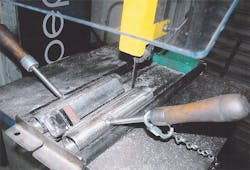In EHS, the state and federal regulations must be met. The question is what tools/methodology are you using to create a culture that is effective and efficient? A safety culture can provide great value—injury prevention, minimized risk and fatalities, a culture of care and team engagement, not to mention a reduction in costs and fines. The key is to focus on the process or system which may not be fully understood due to the varying situations of the specific process, machine, or task.
One team-based methodology that I have had positive results with while solving problems is Mike Rother’s Improvement Kata. The Improvement and Coaching Kata has been proven to be an amazingly effective systematic and scientific methodology. The four steps, according to Rother, are:
1. Understand the direction.
2. Grasp the current condition.
3. Establish the next target condition.
4. Iterate toward the target condition.
The 4-step methodology begins with understanding the challenge or vision, and asking the questions, “Where are we? Where are we going, and what do we what to aspire to be?”
Here is an example, so we can all follow along. The first part of the Kata process is to understand your direction or vision. In safety, the company may have a safety vision statement, or it may be part of the company policy safety statement. Here’s an example:
• Home and workplace accidents are preventable.
• We will lower our injury rate by 20% each year, in 2020 our recordable injury rate goal is 2.7 or less.
• We will be OSHA compliant.
• Every employee’s job has safety improvement work as part of their job responsibility.
Remember that step one provides the direction to strive for, as you will see as we work through this safety-focused Improvement Kata.
Understanding the Current Condition
Observe the process with a cross-functional team, to be sure that one of the members of the team is familiar with the operation or process and how it is currently operating. Refrain from making judgments and ask questions about the process. The goal is to just observe and understand how the current process works. Again, do not go into problem-solving mode as this is not the time for solutions yet.
As a ten-plus year veteran of the Kata process I have learned insightful details about the people and processes just by actively observing the activities and actions of the team members that are involved in the Kata process.
Yes, starting with a picture is critical to communicate the current condition as a picture says a thousand words. Depending on your risk tolerance, you can see what will potentially happen before it occurs. Figure 1 illustrates the potential safety risks in this process.
Current Condition
You must understand the current process before you can improve it (Figure 2). The Kata template frames up the Kata and serves to communicate what part of the process the team is in, and documents the process for others in the work area or other shifts.
People new to the Kata methodology are taught that you will know when you have a good current condition when you can explain it to a stranger, and they understand it.
The Target Condition
The target condition is, “How do you want the process to operate?” Still no solutions yet!
In this example we want to improve safety to decrease the risk of a potential injury (Figure 3). The team’s example is to develop a process that moves the employee’s hands further away from the saw blade or hazard.
Plan-Do-Check-Act (PDCA) Cycles
The PDCA cycles (Figure 4) are where you try to test your ideas to reach the target condition. It is a scientific problem-solving methodology to continue to move the organization forward. After several PDCA cycles you see that the process is much safer. In the improvement process, the employees are using the Kata 4-step process and their supervisor is coaching them to be sure that they are using the process and to assist them if they run into obstacles.
At this point the team achieved the target condition in that they removed risk while remaining efficient and effective in the process. While making it better, the team continued to check and verify as they introduced a new standard, thus providing continuous learning of the process and PDCA cycle. This is another one of the advantages of the Kata method as teams learn throughout the Kata process with increased ownership and engagement of the people.
Reaching the Target Condition after the Last PDCA Cycle
In Figure 5, you can see that after several PDCA cycles that the hazard or risk to the employees has been lowered or improved. The employee’s hands are further away from the saw blade and a guide for the fixture, so it cuts the sample straight. We are not seeking perfection through the Kata process; we are after daily continuous improvement.
It generally is a standard to post the Kata forms and photos in the work area to communicate the improvement project to other people/shifts in the work area. It can also be incorporated into daily huddles or waste walks.
Kata is a methodology that empowers team members to solve problems themselves. Many people that I have worked with use Kata in their personal lives as well. When we think about employee engagement of a process or task, in this specific Kata example the employees owned it. It was their work, ideas and collaboration working together that made their work area safer. It was a win-win outcome because the employees recognized a hazard, and took ownership to solve the problem before anyone got hurt.
The Kata process is also about learning and developing people. If team members have been taught a standardized problem-solving methodology, they can learn and solve other similar problems, which creates a vibrant, proactive culture that improves the workplace environment. The organization’s culture is built on trust and teamwork and overall improves the belief that management cares about the team’s safety as they took the time to train, recognize and coach the Kata methodology.
Rick Price is head of Rick Price Consulting and Training.





